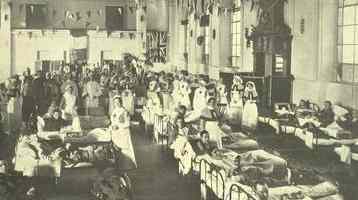How VAD Hospitals operated

A VAD Hospital Ward from a history of VAD by Thekla Bowser
In October 1915 an article appeared in the Journal of Nursing written by the sister in charge of an un named VAD Hospital in which she outlined conditions at her hospital. Her words which will help us understand the situation of trained nurses and how the hospitals operated.
In the hospital of which I am sister in charge, the staff included the Commandant ( young and untrained) , The Lady Superintendent and Night Sister ( Both trained before marriage many years ago), the Quartermaster ( untrained) , a number of VAD nurses and cooks, a housemaid, kitchen maid, porter and boy.
All with the exception of the servants and myself, give their services and I think there is a great honour due to the girls of gentle birth who come in to sweep and polish and scrub.
Our VAD's include the wives and daughters of county magnates, of farmers, tradesmen, gardeners and tradesmen, a jumble, especially when it happens that a daughter and servant come from the same house to be treated for a brief time as equals.
At first I was shown little respect as their senior officer, and I felt they thought a paid worker of less account than 'lady nurses' or 'lady cooks' but I am glad to say that this feeling has worn away.
The only resident members of our staff are the night sister, the head cook, the servants and myself.
I have to be on duty early every morning and late every evening and I can never get a half holiday.
The Lady Superintendent comes daily and on three afternoons in the week she relieves me from 2pm to 7pm and occasionally on a Sunday for 2 to 3 hours. I am on duty all day for the rest of the week.
The Commandant and Quartermaster come daily for two or three hours.
The VAD's have a long day and a short day. On their long day they are on duty from 0830 to 1930 and on their short day they work for about four hours.
They are allowed to come for a week, a fortnight or a month at a time according to their home circumstances.
For our thirty patients we have six VAD nurses and three cooks at one time.
Two of the six nurses are chosen every week to help me with the dressings, and they take great pride in the sterilizing room where they mix lotions, make sponges, cut and sterilize dressings, and prepare every day a supply of boiled water, both hot and cold. They also learn to apply fomentations, to help me with the other dressings and to prepare both room and patient for operations.
Meanwhile the other four are busy with ward, bathroom and pantry work, but they look forward to their week as surgical nurses.


